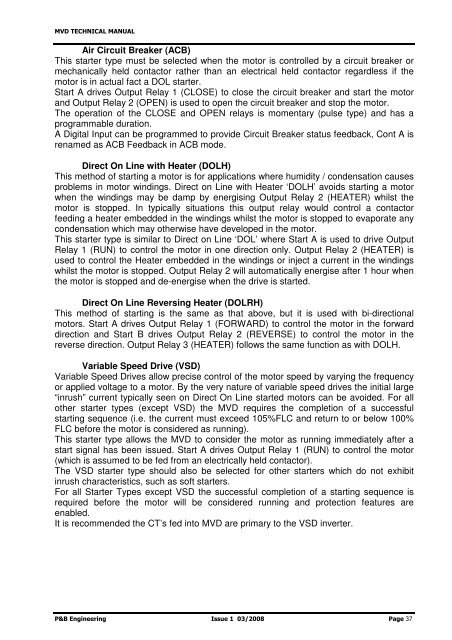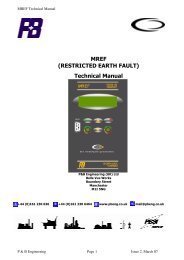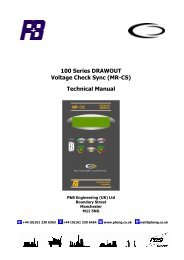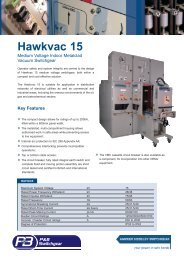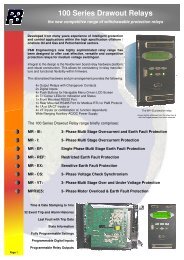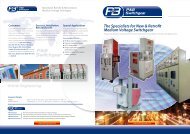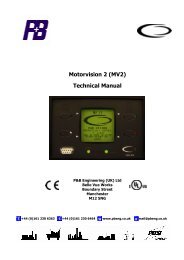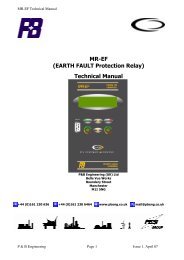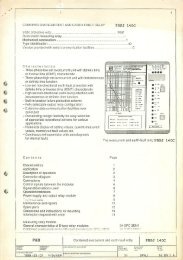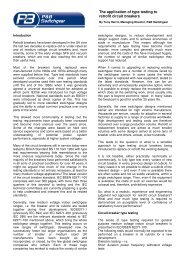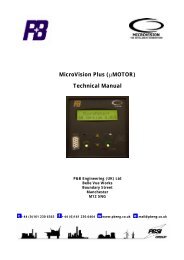Motorvision Drawout (MVD) Technical Manual - PBSI Group Ltd
Motorvision Drawout (MVD) Technical Manual - PBSI Group Ltd
Motorvision Drawout (MVD) Technical Manual - PBSI Group Ltd
You also want an ePaper? Increase the reach of your titles
YUMPU automatically turns print PDFs into web optimized ePapers that Google loves.
<strong>MVD</strong> TECHNICAL MANUAL<br />
Air Circuit Breaker (ACB)<br />
This starter type must be selected when the motor is controlled by a circuit breaker or<br />
mechanically held contactor rather than an electrical held contactor regardless if the<br />
motor is in actual fact a DOL starter.<br />
Start A drives Output Relay 1 (CLOSE) to close the circuit breaker and start the motor<br />
and Output Relay 2 (OPEN) is used to open the circuit breaker and stop the motor.<br />
The operation of the CLOSE and OPEN relays is momentary (pulse type) and has a<br />
programmable duration.<br />
A Digital Input can be programmed to provide Circuit Breaker status feedback, Cont A is<br />
renamed as ACB Feedback in ACB mode.<br />
Direct On Line with Heater (DOLH)<br />
This method of starting a motor is for applications where humidity / condensation causes<br />
problems in motor windings. Direct on Line with Heater ‘DOLH’ avoids starting a motor<br />
when the windings may be damp by energising Output Relay 2 (HEATER) whilst the<br />
motor is stopped. In typically situations this output relay would control a contactor<br />
feeding a heater embedded in the windings whilst the motor is stopped to evaporate any<br />
condensation which may otherwise have developed in the motor.<br />
This starter type is similar to Direct on Line ‘DOL’ where Start A is used to drive Output<br />
Relay 1 (RUN) to control the motor in one direction only. Output Relay 2 (HEATER) is<br />
used to control the Heater embedded in the windings or inject a current in the windings<br />
whilst the motor is stopped. Output Relay 2 will automatically energise after 1 hour when<br />
the motor is stopped and de-energise when the drive is started.<br />
Direct On Line Reversing Heater (DOLRH)<br />
This method of starting is the same as that above, but it is used with bi-directional<br />
motors. Start A drives Output Relay 1 (FORWARD) to control the motor in the forward<br />
direction and Start B drives Output Relay 2 (REVERSE) to control the motor in the<br />
reverse direction. Output Relay 3 (HEATER) follows the same function as with DOLH.<br />
Variable Speed Drive (VSD)<br />
Variable Speed Drives allow precise control of the motor speed by varying the frequency<br />
or applied voltage to a motor. By the very nature of variable speed drives the initial large<br />
“inrush” current typically seen on Direct On Line started motors can be avoided. For all<br />
other starter types (except VSD) the <strong>MVD</strong> requires the completion of a successful<br />
starting sequence (i.e. the current must exceed 105%FLC and return to or below 100%<br />
FLC before the motor is considered as running).<br />
This starter type allows the <strong>MVD</strong> to consider the motor as running immediately after a<br />
start signal has been issued. Start A drives Output Relay 1 (RUN) to control the motor<br />
(which is assumed to be fed from an electrically held contactor).<br />
The VSD starter type should also be selected for other starters which do not exhibit<br />
inrush characteristics, such as soft starters.<br />
For all Starter Types except VSD the successful completion of a starting sequence is<br />
required before the motor will be considered running and protection features are<br />
enabled.<br />
It is recommended the CT’s fed into <strong>MVD</strong> are primary to the VSD inverter.<br />
P&B Engineering Issue 1 03/2008 Page 37


